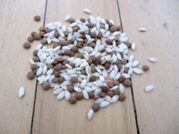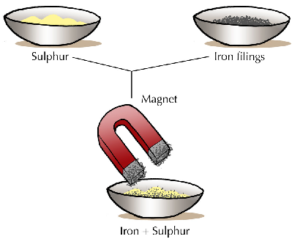Science > Chemistry > Introduction to Chemistry > Methods of Separation of Mixtures
In the last article, we have studied the chemical classification of substances. Most of the available substances in nature are in mixture form. The useful component of the mixture can be obtained by separating individual components of the mixture by a suitable method. The method of separation employed depends upon the nature of components of the mixture. In this article, we shall study different methods of separation of mixtures.
Separation of Solid-Solid Mixtures:
Mechanical Picking:
Property exploited: the physical appearance is different for different substances
In this method, the components are separated on the basis of physical characters like shape, size, and appearance. e.g. Removing stones or husk particles from grains.

Magnetic Separation:
Property exploited: the magnetic property of one component.
Ferromagnetic substances like iron, cobalt, nickel are separated from non-magnetic substances using magnetic separators or magnetic belts. e.g. Separation of iron filings from sulphur using magnet.

Sublimation:
Property exploited: the ability of one component to sublime.
The solids which on heating gets converted into vapours directly (instead of into liquid) are called sublimate or volatile solid and the phenomenon is known as sublimation. This process is used to separate volatile solids from non-volatile solids. In this method, the mixture is heated. The sublimable solid gets converted into vapours living non-volatile substance behind. The vapours of sublimation can be condensed by cooling to get the volatile solid back. e.g. Separation of iodine from sand or separation of ammonium chloride from the sand.

Solvent Extraction:
Property exploited: Solubility of one component in the solvent.
In this process, one of the components is dissolved in a particular solvent in which it is soluble while other components do not dissolve.
e.g. Separation of sulphur and iron. Carbon disulphide is added to the mixture in which sulphur get dissolved and iron remains in solid state. Then the solution is filtered iron particles are filtered out. The filtrate contains carbon disulphide with sulphur dissolved in it. Carbon disulphite evaporates and sulphur remains.
All the compounds of ammonia, sodium, potassium and all the nitrates and nitrites of metal, All chlorides (except chlorides of mercury, silver and lead), all metal sulphates (except sulphates of calcium, lead and barium)n are soluble in water. All metal oxides, hydroxides, carbonates and sulphides are insoluble in water.Organic substances are not soluble in water but are soluble in organic solvents like chloroform, benzene, alcohol etc. Some important substances and their solvents are as follows.
| Substance | Solvent used |
| Chlorophyll | Methylated spirit |
| Grease | Petrol |
| Iodine | Ethyl alcohol |
| Nail polish | Acetone |
| Naphthalene | Benzene |
| Nitre | Water |
| Oil | Petrol |
| Paint | Turpentine oil |
| Paraffin wax | Turpentine oil |
| Phosphorous | Carbon disulphide |
| Rust | Oxalic acid |
| Rubber | Benzene |
| Sulphur | Carbon disulphide |
| Shellac | Ethyl alcohol |
Gravity Separation:
Property exploited: Difference in densities of components.
The mixture containing two components having different densities but both insoluble in particular solvent can be separated by this method.
A mixture of chalk powder and sand is added to water. Due to more density sand particles settle at the bottom of the vessel while chalk particles being lighter floats on the surface of the water.
Fractional Crystallization:
Property exploited: Difference in a solubility of the components in the same solvent.
A mixture of KNO3 and NaCl can be separated by this method. Both are soluble in water. But solubility of KNO3 is more than NaCl. When the saturated solution containing KNO3 and NaCl is heated and allowed to cool down, NaCl being less soluble crystalizes first and it is filtered out the filtrate contains KNO3 which crystallizes on further cooling.
Separation of Solid-Liquid Mixtures:
Filtration:
Property exploited: Size of the insoluble solid component is more than the size of the grid of the filter paper.
This method is used for separating the insoluble suspended particles from a liquid using filtering materials like filter paper, sand bed etc. The liquid that passes trough the filter is called the filrate and insoluble solid left on filter is called the residue. For colloidal particles parchment membrane is used for separating colloidal particles from the solution.
e.g. filtration of water.

Sedimentation and Decantation:
Property exploited; The high density of insoluble solid component.
In this method, the liquid containing insoluble suspended particles is allowed to stand still for some time. The suspended particles settle down at the bottom under gravity. The solid substance that settles down is called sediment. The upper liquid can be separated by decantation. In decantation the upper liquid is carefully poured in another beaker without distrurbing sediments.
e.g. sedimentation of muddy water.

Evaporation:
Property exploited: A solid remains unaffected on heating the mixture up to the boiling point of the liquid. Liquid gets converted into vapours.
In this method, the solid soluble component of the mixture is separated from a liquid. The mixture is heated up to the boiling point of a liquid. The liquid evaporates living the solid behind. The vapours of liquid can be condensed to get liquid back.
e.g. Separation of sugar from sugar in water solution.

Distillation:
Property exploited: A solid remains unaffected on heating the mixture up to the boiling point of the liquid. Liquid gets converted into vapours.and vapours of liquid cooled down to obtain pure liquid.
This method is used to separate liquid from soluble solid. In this method, the mixture is heated up to the boiling point of the liquid, at which the vapours of liquid are formed living the solid behind. The vapours of liquid on cooling condense to give the liquid. The condensed vapours are called distillates.
e.g. Separation of water from salt in water solution.

Note: The difference between the evaporation and distillation is that in case of evaporation, the component evaporated is lost permanently. While in distillation both the components one which is evaporated and one which has no effect are recovered.
Centrifuging:
Property exploited: Density of solid particles is different from that of liquid particles.
In this method, the mixture of solid in a liquid is rotated in a centrifuge. The centrifugal force causes more dense substances to separate out along the radial direction (the bottom of the tube). Whereas the lighter particles will tend to move to the top of the tube.
e.g. Blood plasma can be separated from its solid constituents (RBC, WBC, Platelets) by this method. When milk is stirred very fast the cream particles and milk particles are separated. When rotation or sturring stops cream particles float on the top.

Separation of Liquid-Liquid Mixtures:
Separating Funnel:
Property exploited: Difference in densities of two immiscible liquid components
In this method, the mixture of two immiscible liquids having different densities is taken in separating funnel. The lighter (lower density) liquid forms the top layer while heavier(higher density) liquid forms lower level. Now the bottom valve is open and the heavier liquid is separated.
e.g. Separation of kerosene from the water.

Fractional Distillation:
Property exploited: Difference in boiling points of liquids.
This method is used to separate two miscible liquids having close boiling points (Difference of about 10 K). In this method, the mixture is heated. The liquid having lower boiling point gets evaporated first living the liquid having a higher boiling point behind. The vapours of evaporated liquid can be condensed by cooling to get it back in the liquid state.
e.g. Separation of different components from petroleum.

Separation of Gas-Gas Mixtures:
Diffusion:
Property exploited: Difference in densities of component gases.
The rate of diffusion is inversely proportional to its molar mass. It means the gas with lower molar mass diffuses faster than that with higher molar mass.
e.g. Separation of hydrogen (lower molar mass) from methane (higher molar mass)

Fractional Evaporation:
Property exploited: Difference in boiling points of component gases.
A mixture of liquefied gases is evaporated the respective gases separates out from the liquefied mixture at their boiling points.
e.g. When liquefied air is allowed to evaporate nitrogen having the lowest boiling point boils off the mixture leaving behind oxygen in the liquefied air. on further evaporation, oxygen boils off leaving behind remaining components of air.

Preferential Liquefication:
Property exploited: Difference in liquefication of gases under pressure.
a mixture of gases is liquefied using high pressure. The gas which is easily liquefiable gets liquefied first.
e.g. When a mixture of ammonia and hydrogen are subjected to high pressure, ammonia gets liquefied while hydrogen remains in gaseous state and hence can be separated very easily.
Dissolution in Suitable Solvent:
Property exploited: Difference in the solubility of components in the given solvent.
The mixture of gases is allowed to dissolve in the solvent such that one component is soluble in the solvent. Other component remains in the gaseous state and can be separated easily.
e.g. When a mixture of carbon dioxide and carbon monoxide is dissolved in KOH, carbon dioxide gets dissolved in it while carbon monoxide remains in the gaseous state and thus can be separated.
Separation of Liquid-Gas Mixtures:
Heating:
Property exploited: As the temperature increases, the solubility of a gas in the solvent decreases.
When a solution of a gas in a liquid is heated slightly below the boiling point of the liquid The gas escapes out leaving behind liquid component. The escaping gas can be collected separately.
e.g. Separation of dissolved oxygen from water.
Lowering of Pressure:
Property exploited: The solubility of a gas in a liquid is directly proportional to the pressure on it.
In soda water bottle carbon dioxide gas is dissolved in water under pressure. When the cap of the bottle is open the solubility of the gas decreases and dissolved carbon dioxide gas escapes out leaving water behind.
Miscellaneous Method:
Chromatography:
Property exploited: The different rates of adsorption of different components.
This method was discovered by Michael Tswett in 1906. This technique is based on preferential adsorption of a substance at the surface of the adsorbent. In this method, the mixture is mixed with the liquid in which it is soluble. This liquid is called eluant. Then this solution is poured into a tube containing adsorbing column. Different components of the mixture would adsorb to different extent forming separate layers (Different colours) on the adsorbing column. Depending upon the fixed and moving phases, chromatography is further classified as a paper chromatography, column chromatography, thin layer chromatography and gas chromatography.
e.g. separation of coloured constituents in a mixture of ink.

In chromatography, a very small quantity present in micrograms can be separated. it is used for quantitative estimation. It is used for the purification of many industrial products.
In the next article, we shall study one of the important topic of the chemistry: Naming of chemical compounds and writing formula from the name of the chemical compound.
Previous Topic: Chemical Classification of Substances
Next Topic: Naming of Chemical Compounds
2 replies on “Methods of Separation of Mixtures”
Very nice separating mixtures.
This article has helped me immensely in my project